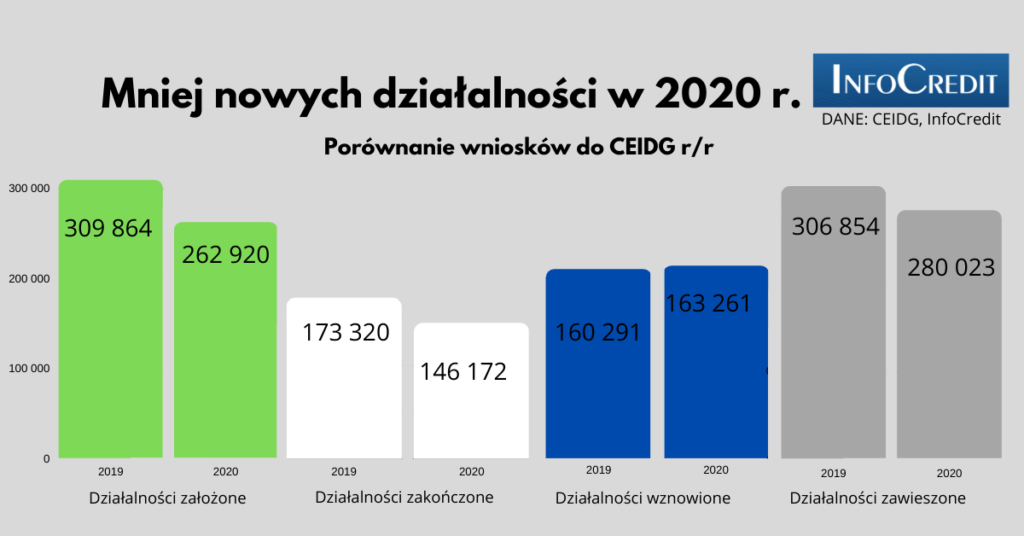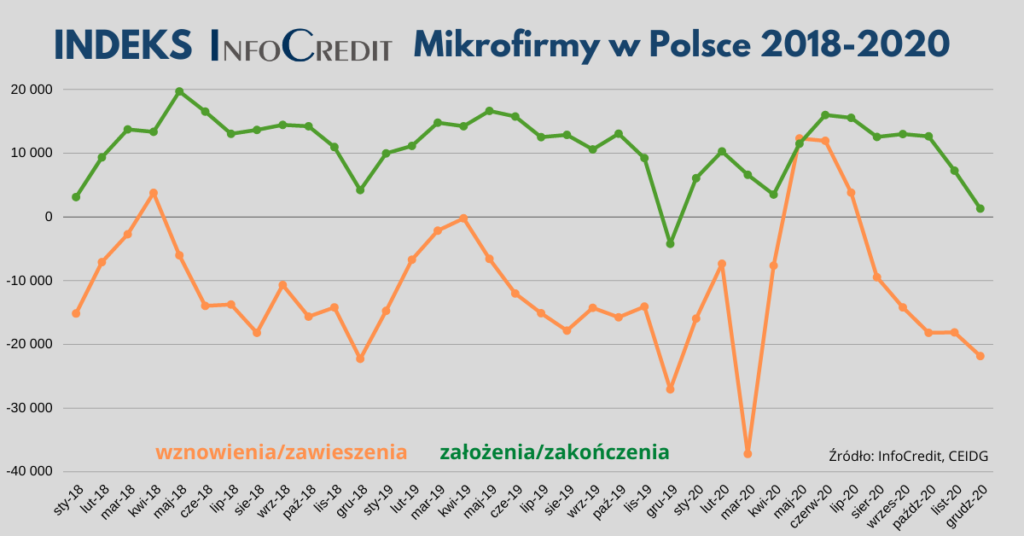Fewer new businesses than in 2019
In 2020, there was less activity than in the previous year
In the whole of 2020, 262.9 thousand businesses were established, 146.2 thousand were closed, 163.3 thousand were resumed and 250.1 thousand were suspended. For comparison – in the same period last year, it was 309.9 thousand (new), 173.3 (closed), 160.3 (resumed) and 306.9 thousand (suspended) respectively – according to CEDIG data.
In December last year, 1306 more businesses were established than closed. The InfoCredit index recorded a significant drop, but its value remained positive (in November 2020 it was + 7263 points). In the last month of 2020, 19.8 thousand businesses were opened, 18.5 thousand were closed.
There were again significantly more people suspending their business in December 2020 than resuming it. The InfoCredit index has thus deepened its decline to -21,834 points. It is the lowest since March 2020, when entrepreneurs, under the influence of uncertainty, began to submit applications for suspension en masse. However, there was no such anxiety as in March. There was also no assault on the CEIDG system.
The last weeks of December did not bring a revival in applications submitted to the CEDG. Although as many as 29,905 activities were suspended compared to 8,071 resumed, the situation was similar to the end of 2019. At that time, 10,312 activities were resumed and 37,381 were suspended. The InfoCredit index, describing the ratio of renewals to suspensions at the end of 2019, was worth -27,069 points, which is much lower than after November 2020. Usually, at the end of the year, there are much more suspensions than renewals.

Compared to November, we noted a significant increase in business closures. In December 2020, there were 18,514 such applications compared to 11,086 a month earlier. There were almost as many new businesses as a month earlier (19,820 compared to 19,493 in November 2020). This is also a seasonal effect. The end of the year favors suspensions and closures, especially with such uncertainty and restrictions as today.
– The last quarter brought a significant drop in activity in submitting applications to CEIDG and this is the only worrying signal from micro-entrepreneurs. This was visible in each category. In the first three quarters of this year, Poles were much more willing to take matters into their own hands. Those who saw their chance started new businesses, and there were much fewer definitely closed businesses than new ones. Those who did not see the chance suspended or closed their businesses. Now they are stuck in limbo waiting for better times – says Jerzy Wonka, Development Director of the analytical company InfoCredit.
According to Jerzy Wonka, the second wave of the epidemic and the increase in cases in the autumn could have influenced the decisions of micro-entrepreneurs. For now, when restrictions in many industries are maintained and extended, and revenues are significantly lower, it is difficult to be optimistic and start or suspend a business. Hence – perhaps – the lower number of applications than at the end of 2019.
The second issue is the much better situation on the labor market than it might have seemed six months earlier. The registered unemployment rate in December was 6.2% – according to preliminary data from the Ministry of Development, Labor and Technology. At the beginning of 2020, it was 5.5%. The economic collapse did not result in a significant increase in unemployment.
– Many people still believe that a full-time job in difficult, unstable times is a better idea than starting a business on your own. This is also the reason why many people could have postponed starting a business in the last quarter of 2020 – adds Jerzy Wonka.
How do we calculate the InfoCredit Index?
The InfoCredit indicator was created to track trends in micro-entrepreneurship, alternative forms of employment and self-employment at a time when the situation on the labor market is changing dynamically. The index, which is developed by the oldest company in Poland analyzing the economy, takes on a positive value when there are more new businesses than closures. When there are fewer than closed ones – a negative value. In the same way, we track the ratio of resumed to suspended businesses.
